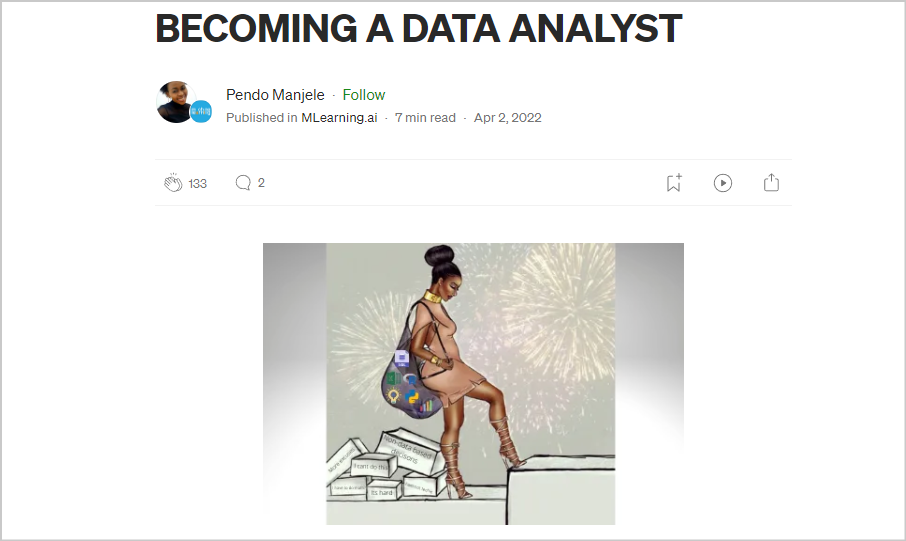Free Data Analytics Course
Jumpstart your journey with 25 essential learning units in data analytics. No cost, just knowledge.
The volume of data produced and captured across the world stood at just over 64 zettabytes in 2020. According to Statista, that number is expected to triple to 180 zettabytes by 2025. To put that into perspective, a single zettabyte is a trillion gigabytes of data. Is it possible to derive meaningful insights from all that data? Thanks to the tools and techniques from the field of data analysis, the answer is yes.
The ability to make sense of such massive volumes of data is immensely useful for a range of businesses. Within those seemingly bottomless troves of data are gems that can help companies better understand their customers, create more effective campaigns and outmaneuver their competitors. And it’s up to data analysts to make those data-driven decisions possible.
For all of those reasons, job opportunities for data analytics professionals are plentiful. The preponderance of jobs is an advantage, but this also means increased competition for each open role. In this article, we’ll show you how you can plan your learning journey and take steps to maximize your chances of having a successful data analysis career.
What Is Data Analysis?
Data analysis is the process of collecting, transforming, and analyzing data with the goal of making better business decisions. There are four types of data analysis:
- Descriptive analytics: This type of data analytics describes what happened with a specific variable under study.
- Diagnostic analytics: The effort with diagnostic analytics is to explain why or how a specific data item behaved in a certain way.
- Predictive analytics: As the name suggests, this form of data analysis attempts to forecast how a certain variable is going to vary over time.
- Prescriptive analytics: This type of data analytics involves prescribing solutions to problems by using graph analysis, simulations, and event processing.
How To Learn Data Analysis: Different Learning Paths
Before you dive into learning data analysis, it’s important to know the options that you have. Not everyone learns the same way, and it’s important to choose a modality that caters to your preferences. Let’s get to know the different ways in which you can pick up data analysis skills.
College Degree
When most people think of picking up skills to land a job, they think of a college degree. And that’s a valid way for you to build the educational foundation required for a data analysis career.
A bachelor’s degree in computer science or information technology will give you the theoretical foundations required for data analysis. Master’s degrees aren’t a requirement at most companies, but if you want to go the extra mile, there are colleges that offer courses in data analytics.
A college degree is a good option if you’re still early in your career, as a four-year degree will give you a broad understanding of a wide range of concepts in computing. That’s an opportunity to figure out whether data analysis is the niche that you’re most passionate about. A college degree does, however, require a significant monetary and time investment.
Bootcamp
Bootcamps are a recent entrant into the world of technical education. And they’ve quickly become a popular choice because they give learners the ability to quickly pick up hands-on experience and become job ready in a matter of months.
Top Recommendations
Here are our recommendations for the best bootcamps:
Springboard Data Analytics Bootcamp
The Springboard Data Analytics Bootcamp was developed in collaboration with Microsoft. Over the course of six months, students are taken through a unique learning journey where they pick up key data analysis skills and apply them to projects. The bootcamp covers common industry use cases in areas such as business and finance, giving learners an idea of what implementing their skills in a professional environment will look like.
CareerFoundry Data Analytics Program
This bootcamp from CareerFoundry covers various data analysis techniques, as well as data visualization. You will also learn how to use programming languages that are common in this field, such as Python and SQL. Apart from the course instructors, students also get access to mentors who assess their projects and help them with any career-related queries that they might have.
Brainstation’s Data Analytics Course
The Brainstation Data Analytics Course is a great choice for anyone who’s learning on a time crunch and wants a gentle introduction to this field. Learners are required to put in just three hours of studying per week over ten weeks. During that time, you’ll learn how to use industry-standard analysis tools like Tableau, and skills like data storytelling and visualization.
Self-Taught Route
For those who enjoy flexibility and are naturally motivated, the self-taught route is a good choice. There is a wide variety of resources that you can turn to to learn data analysis on your own. Let’s take a look at some of the best ones available to you.
Online Courses
These online courses are perfect for self-learners.
Springboard’s Free Data Analysis Course: Python, SQL, and R
In addition to its Data Analytics Bootcamp, Springboard also offers its Free Data Analytics Course: Python, SQL, and R. This course covers all of the basic skills you need to get on your way as a data analyst. Learners will gain a broad understanding of the statistical tools and programming skills used to conduct exploratory and predictive analyses. You will also learn how tools like MapReduce and Hadoop are employed in big data projects.
Data Analysis with Pandas and Python
Udemy’s Data Analysis with Pandas and Python course, which has been taken by over 180,000 students so far, takes you through some of the more advanced concepts in data analysis using Python. It covers topics like data frames, grouping objects, and operations on text data. Note that you do need to have a basic understanding of Python and Microsoft Excel in order to do this course.
Google Data Analytics Certificate
Google’s Data Analytics Certificate is a course offered through Coursera. You can take anywhere from three to six months to complete it, and the course is fully remote. It covers data types and structures, data storytelling, and R programming, among other things. The goal is to get learners to a stage where they can land in-demand jobs in fields like data analysis, business intelligence, and operations analysis.
YouTube Channels and Videos
YouTube channels and videos are a great way to learn more about the day in the life of a given profession. And you can also find videos that will help you troubleshoot a problem, or teach you a new skill.
Top Recommendations
The following YouTube channels and videos are good material for those who are self-learning data analysis.
- Ken Jee: In-depth videos on data science topics and fun sports analytics projects
- Tina Huang: Technical videos on topics like SQL as well as career advice for data analysts
- Freecodecamp.org: One of the best resources out there for free learning material on data analysis and other software engineering topics
- Alex the Analyst: This channel is jam-packed with invaluable information on everything data analysts need to know to succeed in their career
Data Websites, Blogs, and Books
If you’re looking for a taste of the more comprehensive and holistic education that you get from a college education, then consider checking out data analysis blogs and books.
Top Recommendations
Here are a few books and websites that cover specific topics in the field of data analysis.
- The Art of Statistics: How to Learn from Data: A book that shows you how statistical thinking forms the basis for data analysis
- KDNuggets: This website by Gregory Piatetsky-Shapiro is a great resource for beginners to read opinion pieces and technical pieces on a broad range of data analysis topics.
- CareerFoundry: This blog covers both technical information and career advice required for early career data analysts.
- Numsense! Data Science for the Layman: No Math Added: This is an excellent book for beginners from a non-technical background to learn about basic data science concepts.
Follow Experts on Social Media
Learn from the best by following prominent data analysts on social media.
Top Recommendations
Check out these social media stars:
- Mike Tamir: Former Uber Head of Data Science and data science faculty at UC Berkeley
- Monica Rogati: Former VP of Data at LinkedIn and AI advisor
- Alon Halevy: Alon Halevy has worked in top positions at tech giants like Facebook and Google and is also a professor of data science
How To Learn Data Analysis: A Step-by-Step Guide
Regardless of how you decide to learn data analytics, you should still follow these steps.
-
Learn the Fundamentals
-
Learn a Programming Language (or Two)
-
Invest Time in Education and Learning (Set a Schedule)
-
Hone Your Skillset
-
Learn the Popular Tools
-
Gain Practical Experience
-
Find a Mentor
Learn the Fundamentals
Build the groundwork for your career by gaining a strong understanding of these fundamentals:
Probability and Statistics
These are the primary mathematical areas that you need to focus on as an early-career data analyst. Any algorithm or analytical approach that you use in your work will be undergirded by some concepts from probability and statistics. More specifically, you need to be able to work on problems on probability distributions, Bayes theorem, and basic linear algebra.
Data Fundamentals
Once you have a strong foundation in math, you should move on to understanding data. It’s imperative that you understand what data is, different types of data, data processing in computers, and how to convert between data types. If you understand these basic concepts in a well-rounded manner, it becomes a lot easier to wrap your head around the most advanced ones.
Data Structures and Algorithms
It’s essential for every data analyst to have a conceptual understanding of basic data structures and how they’re implemented. That includes structures like arrays, linked lists, stacks, graphs, and so on. What you really need to know is how to choose the right algorithm to solve a particular problem, and how to then implement it.
Learn a Programming Language (or Two)
You don’t need to be an expert programmer at this stage of your journey. However, it is essential that you have a basic grasp of writing programs and manipulate data using them.
Since you’re just starting out, Python is a great choice for your first programming language. It’s beginner-friendly but also has a whole lot of libraries that you can use to integrate data analytical features into your programs.
It’s easy to move on to other programming languages once you have a strong understanding of one. Since Python is an object-oriented language, you’ll find it easy to move on to other object-oriented languages like Java or C++.
You can also easily pick up languages that use other programming paradigms at this stage. Regardless of which specific languages you use, what’s important is that you are able to work with datasets and implement various steps in the data analytics process.
Invest Time in Education and Learning (Set a Schedule)
Regardless of the specific modality you choose, learning data analysis is a process that takes time. Whatever your availability, it’s best to come up with a consistent learning schedule. Consider your current responsibilities and how much time you have to study. This will not only help you pick the right bootcamp for you—it’ll also help you get the most out of the bootcamp you choose.
Make sure that you give yourself enough time to build a strong conceptual foundation in data analysis. It also helps to implement what you’ve learned in the form of data analysis projects.
Hone Your Skillset
There are a few specific skills you need to work on once you have the basics down. Let’s take a look at what they are.
Technical Skills
The following technical skills are a must-have for any data analysis professional.
SQL
Working with databases is something you will find yourself doing a lot as a data professional. You will need to know basic commands in SQL so that you’re able to do that. Learning SQL will also give you the ability to move on to other database technologies like NoSQL and MySQL.
Business Intelligence
The goal of most data analysis is to produce insights that can help solve business problems. So it’s important that you are able to grasp the business context within which your organization functions and can come up with data-driven recommendations to boost profits and gain a competitive edge in the market.
Data Visualization
Not everyone has the ability to understand cold, hard data. Data visualization is a way to transform data into a visual format so that it becomes easy to comprehend. As a data analyst, you should know how to employ data visualizations and communicate your findings to stakeholders in your organization.
Machine Learning
Machine learning has become one of the more popular and widely used techniques in data analysis. If you have a good grasp of machine learning techniques, you can use this to produce programs that largely conduct exploratory data analysis independently. Machine learning is currently an in-demand skill and will greatly ease your job search in today’s market.
Soft Skills
Soft skills are often overlooked by budding data scientists. However, they are essential if you want to be good at your job. Here are a few that you should focus on.
Problem-Solving
You’re going to run into problems that don’t have immediately apparent solutions regularly in your work as a data scientist. For that reason, it’s essential that you have an understanding of problem-solving approaches.
Collaboration
The work of a data analyst can be highly collaborative. You will often find yourself working with data scientists, software engineers, and business analysts as part of your job. In such an environment, collaboration and effective communication are essential skills.
Learn the Popular Tools
Data analysts use a range of tools to streamline their workflow and perform canned functions. Here are a few tools that you should consider learning to use.
Gain Practical Experience
Once you have some knowledge and skills under your belt, it’s time for some real-world projects. Let’s take a look at how you can get some practical experience.
Work on Open-Source Projects
An open-source project is one where the code for the software is publicly available. Anyone can go through the code and recommend changes to it. Contributing to open-source projects is beneficial because you get to see what large codebases look like, and you can write codes in a beginner-friendly, piecemeal manner.
Participate in Hackathons
Hackathons provide a fun, challenging environment for new data analysts to test out their skills. They force you to hyper-focus on a single problem statement and come up with a solution using your newfound skills. An added perk of participating in hackathons is that you get to work in a team. That means that you get to share knowledge with other data analysts and get an understanding of how professionals collaborate on projects.
Pursue an Internship
It isn’t always easy to go straight from your learning journey to a high-pressure professional environment. Internships are a great intermediate step in this process. They allow you to figure out how large-scale data analysis projects are executed without having to take too much responsibility for any one part of the job.
When you do land an internship, make sure that you interact with your colleagues as much as possible. The conversations that you have with the full-time data analysts will be as valuable as any of the work that you do as an intern. These conversations are an opportunity to learn about the day-to-day life of professionals in this field and what potential career trajectories look like.
Create a GitHub Profile To Showcase Your Work
Github has basically become a second resume for anyone working in a software field. A profile on the site is a showcase for recruiters who want to see whether you have practical skills to back your educational background. Make sure that you upload any personal projects that you work on as Github repos and keep your profile up-to-date.
Find a Mentor
Finding a mentor can help you in a couple of important ways. First off, mentors have the experience required to provide their mentees with tailored advice. You can go to your mentor whenever you have doubts about where you’re headed or need to know what skills to add to your arsenal.
Mentors can also help keep you motivated on what is otherwise a rather individual journey. You can build a personal relationship with your mentor so that you can turn to them not just for technical tips, but also counsel and personal advice.
Get To Know Other Data Analytics Students
Jo Liu
App Quality Analyst at Snap Inc.
Sarah Savage
Content Data Analyst at EdX
Cleo Valencia
Student In The Data Analytics Bootcamp at Springboard
Learning Data Analysis and Launching Your Career: Real-Life Examples
Here are a couple of people from whom you can draw inspiration in your journey toward a career in data analysis.
Pendo Manjele

Pendo Manjele started their career, like so many data analysts do, as a software developer. The linked post shows how they were able to move on from development to learning data analysis and landing a job in the field. It is chock-full of practical tips and resources that you can use to pick up key technical skills in data analysis.
Mo Chen
Mo Chen is a data analyst in the financial industry. In the linked video, they go over how they would map out their journey in data analysis if they were to redo it all over again. Chen covers a lot of ground in the video, right from coming up with a learning roadmap to building technical skills and showcasing your skills to recruiters.
How To Learn Data Analysis FAQs
We’ve got the answers to your most frequently asked questions.
What Is the Best Way To Learn Data Analysis?
There is no one-size-fits-all answer for how you should learn data analysis. You can choose between a college degree, bootcamps, and self-learning, depending on which mode works the best for you. Start by considering how much free time you have and what resources you have at your disposal.
What Should I Learn First if I Want To Become a Data Analyst?
If you’re just starting out in your learning journey, then you should focus on basic math and data skills. So you should work on probability, statistics, and theoretical concepts like data types and data conversions.
Is Data Analysis Harder Than Coding?
Data analysis isn’t necessarily harder than coding. That said, coding is just one of the many skills you will use as a data analyst. So it is a broader field than coding.
How Long Does It Take To Learn Data Analysis?
It depends on how much time you have to study, but give yourself at least four months to pick up basic skills in data analysis.
Since you’re here…
Considering a career in data analytics? We can get you there. Don’t take our word for it – check out our student reviews. After just 6 months of study in our fully flexible Data Analytics Bootcamp, we’ll boost you into a job in the field or your tuition back. Get started now with our free data analytics course.











